




NTCA members are committed to protecting you
Everyone should take cybersecurity seriously, managing passwords and being aware of all the possible threats to your personal information, finances and more. That’s not meant to frighten you, because you do have help. NTCA member providers across the nation take your security as seriously as you do, and they work daily to secure the networks bringing you the critical internet-based services you need. Recently, I had the opportunity to share more about NTCA’s cybersecurity efforts for both consumers and broadband providers, including CyberShare: The Small Broadband Provider ISAC, through a meeting with U.S. Cybersecurity and Infrastructure Security Agency Director Jen Easterly.
CISA recently launched the Secure Our World program to raise awareness about cybersecurity best practices and empower the public to take proactive steps to protect themselves online. Resources available to the public include a public service announcement, tip sheets on topics like phishing, multifactor authentication and the importance of creating strong passwords and updating software. And there is even a bingo board to make this critical topic engaging for the youngest internet users.
Also, Cybersecurity Awareness Month each October highlights these important issues and emphasizes that you’re also part of the team helping keep us all safe. While NTCA members work behind the scenes, you can help by recognizing phishing attempts, choosing strong passwords and more. Visit cisa.gov/secure-ourworld for more.
Together, we’ll help keep everyone safe and secure online.
From work and school to games and streaming entertainment services, access relies on passwords. The U.S. Cybersecurity and Infrastructure Security Agency suggests you consider using a reliable tool to manage these key bits of information — password managers.
Memorizing complex passwords for multiple accounts is difficult, or impossible. So, sometimes passwords are too simple and easily hacked. Password managers, though, can help.
A password manager is a software tool that organizes all your passwords. Then, a single master code unlocks this vault — encouraging use of long, complex passwords.
Web browsers, including Safari, Chrome and Edge, have built-in password managers, and these can be accessed across devices like computers and phones. These may suffice for those with only basic needs, but they are limited. For instance, passwords in Apple’s Safari aren’t accessible on an Android phone running Google Chrome.
For more robust options, there is software like LastPass, 1Password and Bitwarden. These work across multiple types of devices and have additional features, such as the ability to generate passwords and integration into your favorite web browser.
Make your master password long, reliable and unique. Sixteen characters is recommended. Also, regularly review your stored passwords to remove passwords for accounts you no longer use.

Readers today can find themselves facing a technological conundrum. While many book lovers treasure traditional books, electronic devices, designed to make reading more comfortable and accessible, are hard to ignore.
For some, there’s nothing like the sensation of holding a book and feeling the paper as the pages turn. Printed books will always have emotional, if not monetary, value as collectibles. And they certainly aren’t going anywhere.
These days there are countless options of things to download and read on our phones and tablets, but dedicated, handheld electronic book readers, often called e-readers, offer text and lighting customizations and many other conveniences to enhance the reading experience. Nonreflective, electronic-ink displays give them a paper-like look and make it easier to read outdoors compared with reading on a phone or tablet. And, dedicated e-readers present fewer distractions — you won’t be interrupted by notifications, calls or texts.
Over the past few years, the price of e-readers has fallen while the hardware has improved. High-end features, such as backlit, high-resolution screens and waterproofing, are standard. If you don’t have an e-book reader, there’s never been a better time to invest in one.
• Portability: E-readers are lightweight and can store thousands of books.
• Customization: Most allow you to adjust the font and size, background
lighting, etc. They can make reading accessible for individuals with visual impairment by providing text-to-speech and other customizations.
• Searchability: E-readers’ built-in search functions mean you can easily find a favorite quote or passage in the book.
• Built-in resources: Dictionaries and thesauruses allow for immediate definitions.
• Environmentally friendly and affordable: No trees are harmed in e-book production, and they usually cost much less than traditional books.
Amazon Kindle is synonymous with e-reader for good reason. According to both Wired magazine and The New York Times’ Wirecutter, the Kindle is the most affordable, best and easiest choice for reading electronic books.
• Amazon Kindle: With a 6-inch screen and a high pixel density for sharper text, the least expensive Kindle — around $100 on Amazon — offers just about all the advantages of the more expensive e-readers. If you’re planning on reading outdoors this summer, it’s worth the extra charge, roughly $50, to upgrade to the waterproof Kindle Paperwhite with its better lighting options.
• Rakuten Kobo: Japanese retailer Rakuten currently offers six Kindlecomparable e-readers ranging from $110 to $400. The Libra 2 has a physical page-turn button and Bluetooth
support, so you can connect headphones and listen to audiobooks.
• Barnes & Noble Nook: The book retailer’s e-reader features a touch screen and page-turning button, as well as the ability to annotate and highlight text. The devices start around $100. As an added perk, Nook owners can read the complete contents of any book for free while in stores for one hour per day.
Once you’ve settled on an e-reader, where do you find the books? Amazon, Barnes & Noble and Kobo all sell tomes to download to their specific e-readers. But you could read for years without having to spend another dime. Sources of free e-books include:
• OverDrive.com, used by 43,000 libraries and schools worldwide, allows anyone with a library card to pull e-books, magazines and audio books.
• Project Gutenberg, a library of more than 70,000 free e-books to download or read online. Thousands of volunteers digitize and proofread the books available at gutenberg.org.
• Mybookcave.com
• Planetebook.com
• ManyBooks.net
• OpenLibrary.org
• GetFreeEbooks.com
We’re in the “dog days of summer.” Did you know that phrase dates back to the Romans? When I hear it, I always think about long, hot days perfect for a dip in a lake or pool, or a family gathering beneath a shade tree. It’s a time of year bookended by two of my favorite holidays — the Fourth of July and Labor Day.
 GREG SMARTT General Manager/CEO
GREG SMARTT General Manager/CEO
One of the many things I enjoy about my role with Ben Lomand is seeing all the ways our community comes together. We’re more than a communications company. We not only want to provide you industry-leading services — like internet as fast as the summer is hot — but we also have a deep, lasting commitment to helping this place we call home thrive.
There’s no better time than summer to experience the energy, bustle and cherished traditions that make being outdoors so enjoyable. From the Fourth of July with fireworks that light up the night sky to Labor Day and its laid-back barbecues, these holidays are benchmarks in the rhythm of the year. But they go beyond the festivities and events. They carry a deeper significance, a reminder of the values we hold dear and the ties that unite us.
For us, the Fourth of July isn’t just about celebrating independence. It’s about coming together as a community to honor our shared heritage and celebrate our freedoms. We also remember those men and women who served our nation, because we would not be where we are as a community or nation without their service and sacrifice. In fact, this year BLC will join First National Bank of Middle Tennessee in co-sponsoring the Freedom Fest Fireworks event at the Milner Recreation Center in McMinnville. We hope you can come out and join us for some food, fun, fellowship and fireworks on July 4th.
And then there’s Labor Day, a time to pause and reflect on the hard work and dedication that built our community and the nation’s economy. Workers play vital roles in our past, present and future, and we’re proud our services make much of this work possible. Often the economies of rural places like ours are dismissed, but we see the work and commitment that make the businesses in our region possible. These efforts are worth celebrating every day.
But perhaps what’s most remarkable about these holidays — really this entire summer season — are the connections we make along the way. In a world that often feels increasingly disconnected, the traditions tie us not only to this place but also to each other, and we’re all the better for it.
At Ben Lomand, we’re acutely aware of the role we play in fostering this sense of community. It’s a responsibility we welcome, whether that means providing access to high-speed internet, supporting our schools, sponsoring Fourth of July events or any other service we can provide. Together, we make this place all that it is, and I look forward to seeing you out and about during the “dog days.”
The Ben Lomand Connection is a bimonthly newsletter published by Ben Lomand Connect, © 2024. It is distributed without charge to all member/owners of the cooperative.
is a member-owned corporation dedicated to delivering advanced telecommunications technology to the people of Middle Tennessee and the Upper Cumberland, including all of Grundy, Warren and White counties, and portions of Coffee, Cumberland, DeKalb, Marion, Bedford, Franklin, Van Buren and Rutherford counties.
Ben Lomand Connect is an equal opportunity provider and employer.
Ben Lomand Connect
311 N. Chancery St. • P.O. Box 670 McMinnville, TN 37111 Telephone: 931-668-4131 or 800-974-7779 benlomandconnect.com
Cain Rogers, President, White and Putnam counties
Jeff Flatt, Vice President, Warren County
Donald Hillis, Secretary/Treasurer, Van Buren County
Roger Bynum, Coffee County
Randall Day, White and DeKalb counties
Joe C. Roper, Coffee, Bedford, Rutherford and Franklin counties
Gerald Sitz, Grundy and Marion counties
Bobby A. Thompson, Grundy County
Dr. Ray Troop, Warren County
On the Cover:

The Stoker-Stampfli farmhouse has stood for generations. It was restored to its original state when the farm became a museum. See story Page 12.

James “Will” Foster, of Coalmont, is the recipient of a Foundation for Rural Service General Scholarship of $2,500.
Will, a recent graduate of Grundy County High School, is the son of Trey and Sissy Foster, and plans to attend The University of the South in Sewanee.
“Being selected to receive a FRS scholarship was not an easy accomplishment. We received over 1,300 applications from across rural communities for the 55 scholarships to be awarded,” Pam Becker, FRS executive director wrote. “Please take pride in knowing that your awardee’s application was stellar and showcased not only their academic dedication but pride in their rural community.”
Longtime board member Donald Hollingsworth, 81, died Sunday, May 19, at his home. He was the Van Buren County, Area 5 director from 1975-2017. His history with Ben Lomand Telephone dates back even further to his father, H.L. Hollingsworth, who was also a longtime board of director and knocked on doors with the original petition seeking signatures to form the cooperative.
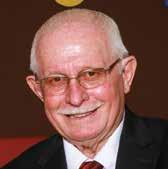
Several Ben Lomand Connect employees took part in Read Across America this year, reading to students at Bobby Ray Elementary School and West Elementary School, both in McMinnville.

“Mr. Hollingsworth was a dedicated servant to not only Van Buren County but to the cooperative as well. This is a huge loss for not only the Van Buren community, but for our service area as well. From his mind, heart, and soul nobody was quite built like him. He was truly Mr. Van Buren County and will be greatly missed by all of us at Ben Lomand Connect,” BLC GM/CEO Greg Smartt says.
Ben Lomand Connect employees Shane Rigsby and Griffin Myers enjoyed participating in the Van Buren County Ag Day on May 2 where they shared information about their jobs with kindergarten through sixth grade students.
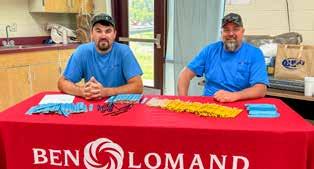
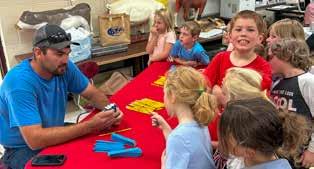

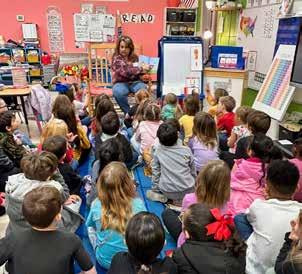
Ben Lomand Connect offices will be closed Thursday, July 4, in honor of Independence Day.


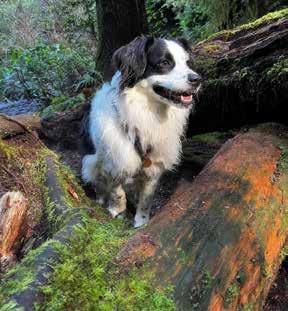 Story by KATHY DENES
Story by KATHY DENES
Summer typically means travel time, whether scenic road trips or flights to vacation destinations. And more than ever before, beloved pets are tagging along for the ride.
Pet-friendly travel is a hot topic. It’s addressed by top vacation resources like Conde Naste Traveler, which has an online list of nationwide hotels and Airbnbs it deems best for accommodating pets, especially dogs. On travelandleisure.com, search “pets,” and you’ll unleash a wealth of helpful articles.
Even financial companies are weighing in.
NerdWallet compiled a list of Best Hotels for Pets in 2024, based on factors like fees and amenities, and rated air travel options, topped by Alaska Airlines. But if you don’t want to do the research yourself, there are travel agencies that specialize in planning and taking care of the details for you.
Hotels, resorts, parks and campgrounds usually post their pet policies, fees and amenities, as do airlines, trains and even cruise lines that allow passengers with paws. There are also numerous websites focused entirely on petfriendly travel, across the nation and around the world. Just browse by city, state or destination at resources such as:
• bringfido.com
• petswelcome.com
• tripswithpets.com





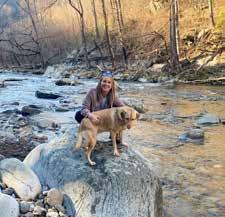


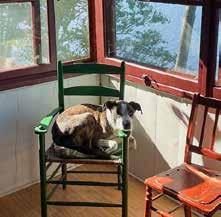

“Before deciding to bring your pet along on a trip, you need to ask yourself whether or not it’s in your pet’s best interest to do so,” says Dr. Rena Carlson, president of the American Veterinary Medical Association.
What’s a fun adventure for us might be overwhelming for our pets. “If you choose to include your pet, a pre-trip veterinary visit is a good idea, to make sure your pet is healthy and up to date on vaccinations and microchip registration, and to obtain a health certificate, which is required by law if you’re traveling to a different state with your pet,” Carlson says.
Your veterinarian can also provide vital information about the risk of parasites and other diseases that your pet may be exposed to at your destination, as well as possible preventive steps or treatments.
“Make sure to plan for their comfort in transit, whether by land or air, with regular breaks and by choosing the least stressful travel options,” Carlson says. “Confirm in advance that your destinations are pet-friendly, and try to maintain your pet’s routine as much as possible to help them feel secure. Your careful planning can ensure a safe and enjoyable trip for everyone involved.” For more great tips for traveling with your pet, check out: pettravel.com petfriendlytravel.com avma.org
Whether taking your pooch along for a carriage ride in Charleston — child’s ticket required if Fido won’t fit in your lap — or entrusting it to doggie day care at Dollywood while you ride the Mystery Mine, the Southeast is loaded with places that welcome four-legged travel buddies.
Here are a few destinations that receive high marks from people traveling with their pets:
• Little River Canyon National Preserve atop Lookout Mountain in North Alabama welcomes dogs parkwide, but they must be leashed.
• Chattanooga has inviting options, from downtown patio dining and parks to mountain trails and attractions.
• Dinosaur World in Cave City extends a Kentucky welcome to leashed dogs and provides water stations.
• Barkwells, gated retreats in Asheville and Brevard, North Carolina, have dog-centric cabin and cottage rentals, each with a fenced yard and a range of amenities to make it a haven for both pets and people.
• For South Carolina excursions, check sciway.net’s pet travel guide for info on rentals, parks, beaches, eateries and more.

• St. Augustine, Florida, gets a nod from AAA for pet-friendly options, like strolls, visits to popular attractions and perhaps a stay at the historic Bayfront Marin House.

When Rachel Killebrew hired a carpenter to work on her McMinnville home in 2008, she noticed he always had a boat in the back of his truck. One day, she asked why. That man, Ernie Campbell, told her he had experienced a personal tragedy and found nature helped him cope.
McMinnville Rotary Friends of the River Cleanup
Registration begins at 7:30 a.m., cleanup begins at 9 a.m.
Saturday, July 20
For more information, visit the McMinnville Noon Rotary Facebook page.

“When I get so emotional I can’t handle it, I go out on the river and it calms me down,” he told her. “The river’s always been my friend, but the river is not calming me down. It’s full of trash. It’s actually making me more upset than ever.”
Knowing Rachel was a member of McMinnville Breakfast Rotary, which has since been incorporated into the McMinnville Noon Rotary as one organization, Ernie asked her if the group could help. Rachel took the request to the group’s president, who was traveling north and offered to compare the condition of the rivers there to those in Warren County. “He came back two weeks later and said, ‘Our river is in terrible trouble,’” Rachel says.
So, the McMinnville Rotary Friends of the River Cleanup was born, in honor of Ernie. Now in its 17th year, the effort has cleared 60 tons of trash from banks of three main rivers.
Rotary Chair Neal Cox says the cleanup is good for the environment and helps show off McMinnville, a tourist town where people enjoy time on the water. “McMinnville Rotary wants to take credit for all the people from all over the world who come to kayak here,” he jokes.
DIGGING DEEPER
The cleanup’s first years were the hardest with the challenges of raising awareness, organizing teams and learning the


best ways to collect a tremendous amount of garbage. “There were refrigerators, washing machines, things that had been in the mud so long, humans couldn’t pull it out,” Rachel says. They didn’t give up and brought in horses for the job. Five of the 10 horses used in the early days belonged to Neal.
In addition to the refrigerators and washing machines, Neal recalls seeing 55-gallon drums and a conveyor belt. “Some of them had concrete in them,” he says.
Then there were the tires — so many tires. “That first year, we pulled out 300 tires in 3 miles,” Neal says. Tires continue to be a major part of the cleanup. In the 16 years since the effort began, volunteers pulled about 3,571 tires out of the river. “But we’re seeing a big difference,” he says. “We’ve gone from 300 that first year to 50 last year.”
Horses are no longer necessary, and the event evolved in other ways. Through sponsors like Ben Lomand Connect, the cleanup now has a $10,000 annual budget. Instead of hauling out trash on borrowed inner tubes covered with plywood, the Rotary now owns 25 flat-bottom boats for that purpose. They organized a way to gather the trash brought up on the banks at collection points and sort it for recycling — 87% of the trash collected, mostly tires, is recycled. They discovered children are among the most enthusiastic helpers, and they learned just how impossible the task seems.
“It became pretty obvious we were never going to be able to handle 100 miles of river in one afternoon,” Rachel says.
That realization led the club to organize an Adopt-a-River program, allowing any individual, family, business or nonprofit to choose a section of the river to keep clean.
LEFT: Members of an Interact Club team show off some of the many tires they pulled out of the river.
BELOW: Neal Cox directs cleanup volunteers.

Rachel says groups have adopted 57 of the 90 adoptable miles of river since the program launched about 10 years ago.
Some families and organizations make a day of it. The Tanner and Galligan families clean their mile, then get together on the riverfront for a cookout and party. McMinnville Water Department employees have a picnic, then disperse to clean the river wherever there is an intake or output area.
Even if a spot is adopted, Rotary Club teams will still work there on cleanup days. Neal says it may be a spot that the adopters haven’t been able to clean in a while, or it may be mostly clean and organizers just want it sparkling for visiting kayakers.
The number of volunteers for cleanup day varies. In 2019, 450 showed up. Last year, there were 200. Since it began, 3,785 volunteers have helped clean up the river. Neal is hoping for a good crowd for this year’s event on July 20.
The program provides a few incentives besides the satisfaction of a job well done. The first 100 participants get T-shirts, and breakfast and lunch are provided. This year, Rotary is looking for a lunch partner.
The Rotary Club supplies potential volunteers with all personal supplies for the cleanup days. In addition to the flat-bottom boats, the club owns eight canoes and has access to 10 more and 10 kayaks. The group also provides more than 200 life jackets, gloves, TWRA-supplied trash bags and safety kits.


The cleanup has gone from covering 3 miles of river that first year to about 50 miles along the Barren Fork, Collins and Hickory Creek rivers. And as it continues to grow, it needs more volunteers and friends for the river.

Wearing a plaid shirt and a gray Froberg’s Farm cap, Tyler Froberg shares a cool fact about a favorite fruit with youthful viewers. “Every strawberry in the world is picked by hand,” he tells eager young minds. “And it takes half an hour to pick one row.”
Most fruit and vegetables are harvested by machines, which helps the fourth-generation farmer talk about farming as a STEAM — science, technology, engineering, arts and math — career option he promotes in a video for Lego’s education branch, known as Rebuilding the World with Agriculture.
Tyler has made a few videos for Lego, promoting schoolbased projects like building a strawberry-picking machine that won’t destroy the delicate fruit. But his screentime isn’t
limited to collaborations with Lego. As Farmer Froberg, Tyler has more than 780,000 social media followers learning about gardening, farming and life on a fruit and vegetable agritourism farm.
TEACHING THROUGH VIDEOS
When he first got out of the Army, Tyler worked on the family farm in Alvin, Texas. “I decided that I had my GI Bill, so I should probably go to college,” he says.
After earning a degree in agriculture, he worked for a year as an agriculture science teacher. “I loved it, and when you love something, you tend to be good at it, and when you tend to be good at it, you get recognition for it,” he says.
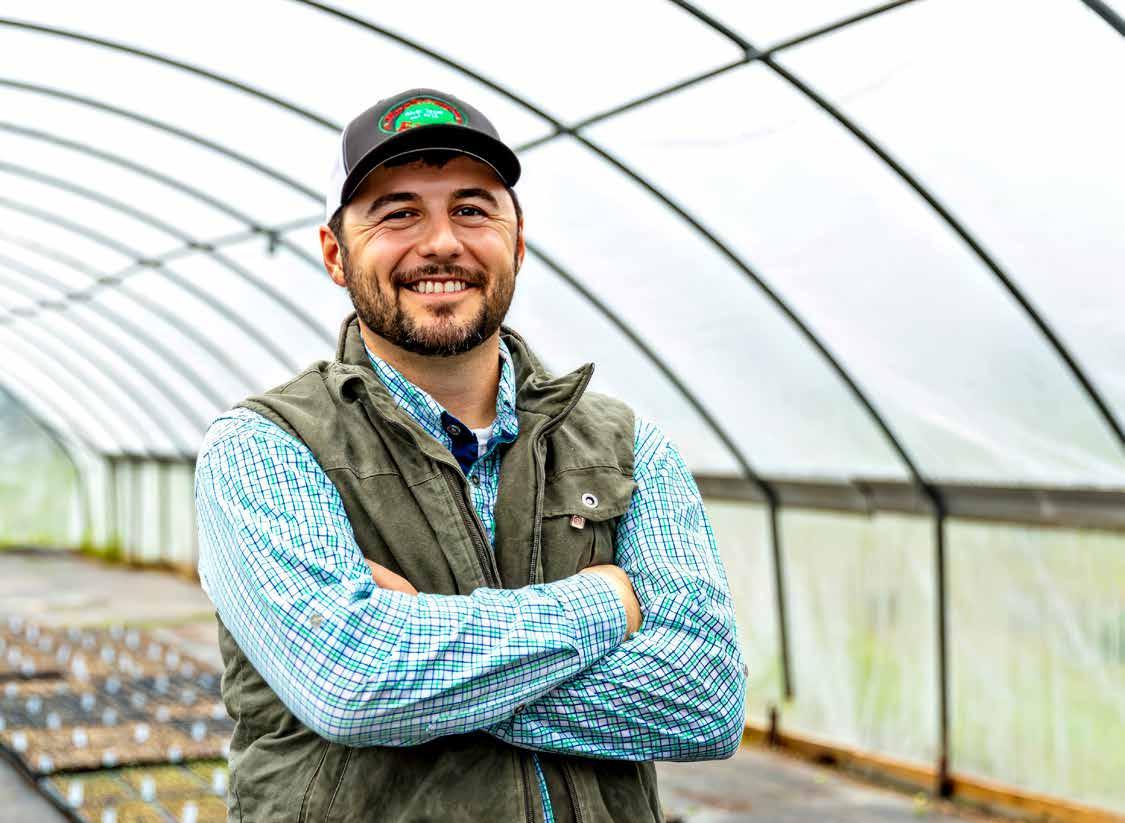
“I think I achieved something that I never thought I would through social media.”
— Tyler Froberg @farmer.froberg
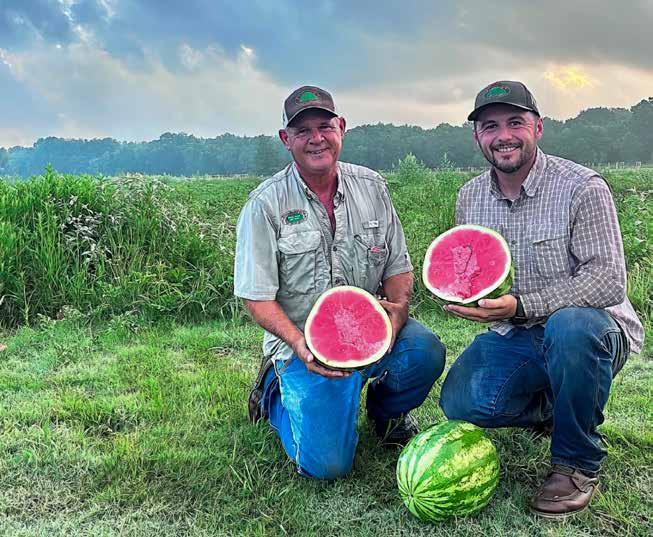
A nonprofit recognized Tyler as the person it needed to run a program teaching farm skills to fellow veterans. “When I was there, though, I missed the spark that you got with young people, whether it was seeing a seed germinate or seeing an animal being born,” he says. “While I was teaching adults, I didn’t see the same spark.”
Around that time, TikTok became popular, and Tyler got an idea. “I should make little videos, like ag lessons,” he says. “I’m still a teacher, and maybe that will scratch that itch. And so, I did.”
In the first two months, several of his videos got a respectable number of views. “I had a video hit 10,000 views, and then I had a video hit 250,000 views, and I was like, ‘Huh, there might be something to this.’”
Tyler has posted a few poems, tried growing square watermelons and loofahs, and succeeded in growing star-shaped zucchini. He’s even zipped layers of jackets to the tune of “Stand by Me” — which got over 5 million views the first time he posted it. But his favorite videos to make are any with his sons in them. “We just laugh and have fun,” he says, talking about “Little Frobergs” Dusty, Carson Lee and Tommy “Tomcat.”
“I’m not one of those content creator parents that are like, ‘No, no, no. You have to say that this way,’” he says. “It’s only been three years, and so, it’s still kind of new for us. They get excited to go out and film with me.” Tyler’s wife, Kristi, known on social media as “Momma Froberg,” also gets the occasional guest spot.
Tyler’s made plenty of silly videos. His personal favorite involves being a rubber duck farmer. “There were these rubber ducks everywhere, and it was just a lot of fun,” he says.
Despite his following on social media, Tyler doesn’t consider himself an influencer. “Influencers are putting on makeup trying to influence you to use this certain brand or product, or there are ag influencers who create content for people in the ag industry. They work with brands and influence followers to use certain brands or products, and I don’t feel like I do that.”
Tyler says there are a few stages every content creator goes through. The first step is embarrassment. “You don’t want anybody you know to know that you’re creating content,” he says.
LEFT: Tyler, right, and his uncle, Alfred Froberg, show off watermelons grown at Froberg’s Farm. BELOW: Tyler enjoys making social media videos with his sons, or, as he calls them online, “Little Farmer Frobergs.” Tyler and his son, Dustin, have fun sharing gardening lessons.
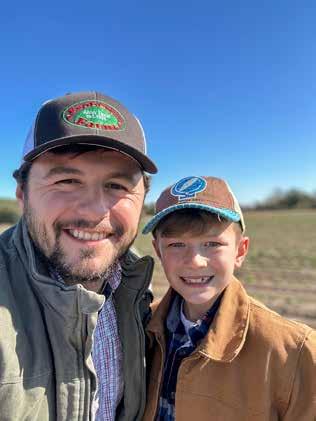
“Then comes, ‘So you’re still doing that thing?’” he says. “That’s when you see your mom and she’s like, ‘Oh, you’re still making the little videos. It’s so cute.’”
The third phase is thinking content creation is a waste of time. “You’re starting to take it more seriously,” he says, “but you’re not getting a lot out of it yet.”
Then there’s the final step — success. “For me, I got invited to give a commencement speech at a college graduation, and walking out on stage and realizing, ‘oh wait, I think I did it.’ I’m still not 100% sure, but I think I achieved something that I never thought I would through social media.”
What about those strawberry-picking machines?
“I would like to think that Lego went as far as they could with that and got hundreds of thousands of submissions for strawberry-picking machines, but I don’t know that to be true,” he says. But he planted the seed of an idea. Now it’s time to see what grows.
Tyler Froberg’s videos are available on Instagram and TikTok at farmer.froberg. His YouTube and Facebook accounts are under the name Farmer Froberg. For more on his family’s farm, go to frobergsfarm.com.
Jackie Lawley remembers waking up in the night as a small child back in 1945 and heading to the outhouse in the backyard. Her house didn’t have a bathroom, and there was no warmth flowing from furnace vents. Instead, she found a place next to the fire to keep warm on frosty winter mornings.
Jackie still lives in that house today with her husband, Marvin. It now has electricity, running water and a place in history.
The lives lived on Jackie’s land — and across the surrounding area — tell the story of how Swiss culture and traditions found their way to rural Tennessee. For nearly five decades, the Grundy County Swiss Heritage Festival celebrates that history every summer.
The farm where Jackie’s house sits was established in 1869 when a group of Swiss immigrant farmers set up the colony of Gruetli with the help of the U.S. and Swiss governments. About 100 families bought 100-acre parcels in the area now known as Gruetli-Laager at 50 cents an acre, Jackie says.
Only five of those original farms remain, Jackie says, with just four of the farmhouses still standing. The rest have been lost to time
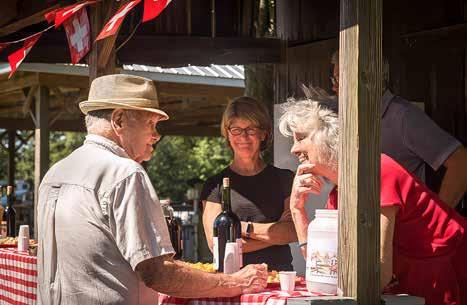
or fires. A hotel from the original village survives, though it badly needs restoration, as does the original post office, Jackie says
Schweizerdeutsch, a Swiss-German dialect spoken by the settlers and their descendants, faded away in the 1940s, when no one wanted to be associated with the Germans during World War II. “You didn’t speak the language in public after that,” Jackie says. But while growing up she tried to understand it. “I would listen once in a while when my grandfather’s brother would come to visit from Nashville. I would sit on the porch and try to understand what they were saying, and that’s the most German I ever got,” she says.
Jackie’s Swiss great-grandfather bought the property her home sits on in 1885 from one of the original Swiss settlers, who moved on to become a butcher for the bishops at the thennew University of the South.
While Jackie and Marvin, both construction workers, have brought their home into the 21st century, much of the original charm remains. “Now, my house is very modernized, but it still has many of the original features,” she says. “A lot of the old boards that are as wide as 16 inches are still on the ceilings and the living room walls. The old paneling from that time period

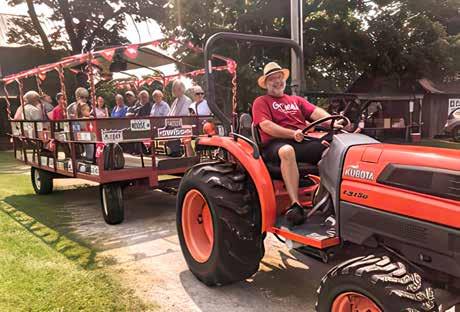

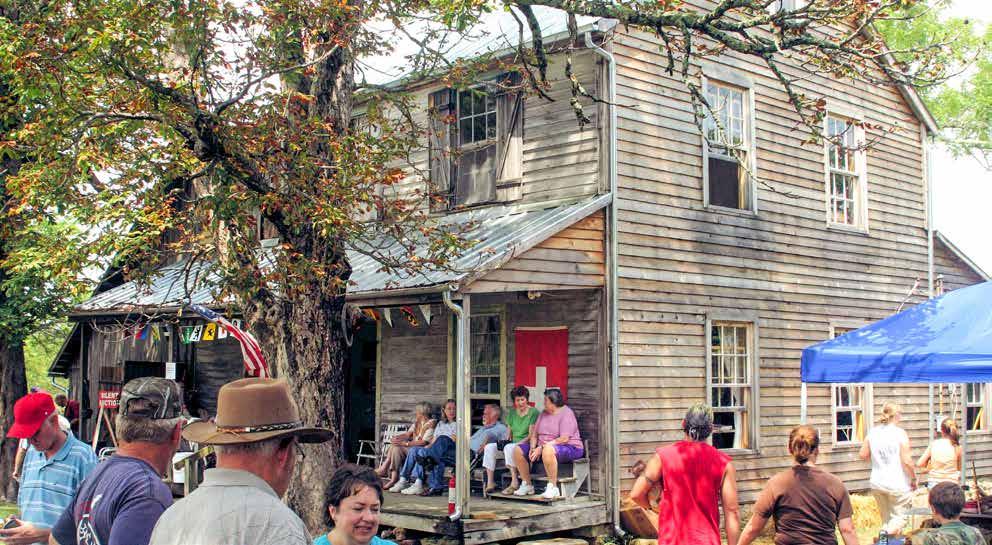
Grundy County Swiss Heritage Festival
Saturday, July 27, 10 a.m.-4 p.m.
Stoker-Stampfli Farm Museum
328 Swiss Cemetery Road, Gruetli-Laager swisshistoricalsociety.org

has been exposed in the master bedroom on the main floor. And the original two rooms still have their original wide plank wood floors, walls and ceiling.”
Jackie and Marvin built an addition to the house, and now instead of no bathrooms, it has three. “So, my husband and I, together with some help, have done a lot of reconstruction, but we tried to keep everything as near the original as possible,” she says.
As president of the Grundy County Swiss Historical Society, Jackie is involved with a much less modern Gruetli-Laager farm — the Stoker-Stampfli Farm Museum. The site is named after the family that originally settled the land and another that lived on the property for about a century.
The farmhouse has been taken back in time — all modern amenities were removed and the home’s original features restored. The house does have electricity, but it’s largely for security purposes. There are no bright light fixtures or appliances. The bathrooms that were installed in the building’s relatively recent past have been ripped out and now — like Jackie’s childhood
home — the toilets are outdoors. “They’re a little more modern than what was once there,” Jackie says. But do they flush? “No, you still have to regularly sprinkle a little lime in there.”
In addition to the original house, the barn, cheese house and vineyard remain, as does a cabin, in dire need of restoration, that may be the oldest structure on the property. The now-30acre farm is home to the annual Grundy County Swiss Heritage Festival. The festival celebrates its 49th year this July, and Jackie has been there for all of them. It began the same year as the Swiss Historical Society, which her father helped set up and which she has also served since the beginning.

In addition to about 700 festivalgoers, the Consul General of Switzerland visits every three years from Atlanta. The consulate sometimes provides some funds for the festival, whether paying for a band or for new flags.
The musical guest for this 2024 festival is a longtime favorite, the Musik Meisters, a Nashville-based German alpine polka band. “We have vendors who will have some goods, and sometimes we have soap making and yarn making and that sort of thing,” Jackie says. “We try to have as many old-time things as possible, but not many people are doing that kind of thing anymore.”
The festival also features wine and cheese tastings for the adults and hayrides for children of all ages. And, maybe, when attendees step away from the crowds for a moment, look over the hayfields and old structures and think about the Swiss pioneers who settled the area. Perhaps, they’ll be able to see history through pioneers eyes, if only for a moment.

Among summer’s many charms are vegetables and fruit blooming with flavor, and it doesn’t take a lot of effort to turn them into delicious salads.
These recipes cover all the salad bases. From crisp leafy tossed salads to sturdy mixes that can sit out for a couple hours while the kids play in the yard and you visit with friends. Keep it easy and choose a makeahead recipe featuring hearty pastas, grains and beans that can work as a side dish or a full meal, or throw together fruit or vegetable combinations that hit sweet or savory notes.
Summer salads are versatile, so feel free to swap out lettuces, and use a variety of fruits instead of just one kind. After all, it’s summertime, and the living — and cooking –should be easy.

Food Editor Anne P. Braly is a native of Chattanooga, Tennessee.
1 pint fresh blueberries
2 peaches, diced (leaving the skin on adds texture, vitamins and color)
2 cucumbers, sliced 1/2 cup crumbled feta cheese
3 tablespoons fresh lemon juice
1 tablespoon Dijon mustard
1 tablespoon honey
1 tablespoon olive oil
1 tablespoon finely chopped basil Kosher salt and freshly ground black pepper, to taste
In a large serving bowl combine the blueberries, peaches, cucumbers and feta.
In a jar with a lid or measuring cup combine the lemon juice, Dijon, honey, olive oil, basil, salt and pepper. Whisk together until well combined.
Pour the vinaigrette over the salad and gently mix everything together. Taste for seasoning and garnish with extra basil. Serve or cover and refrigerate the salad until ready to serve.
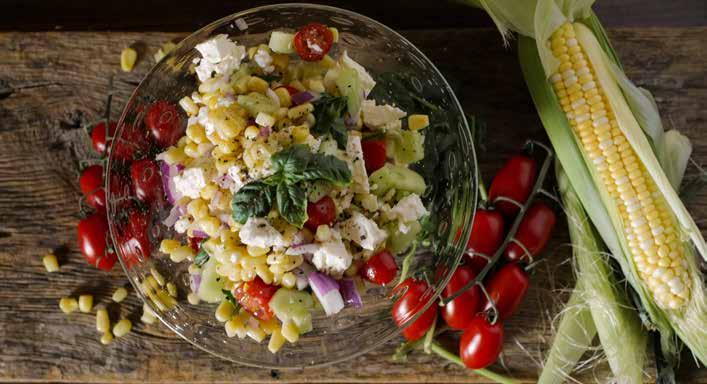
3 cups corn kernels (approximately 4 ears)
1 cup cherry tomatoes, quartered
1 cup cucumbers, diced
1 cup crumbled feta cheese
1/4 cup red onion, diced
3 tablespoons olive oil
3 tablespoons rice vinegar
1 tablespoon fresh parsley
Fresh basil ribbons
Kosher salt and freshly ground pepper, to taste

Bring a large pot of salted water to a boil and add the corn. Cook for 3 to 4 minutes or until the kernels turn bright yellow. Drain the corn and cool completely. Use a sharp knife to remove the kernels from the corn cob, scraping the cobs to get all the “milk” from the cobs.
In a large bowl, combine the corn kernels, cherry tomatoes, cucumbers, feta cheese and red onion. Drizzle the olive oil and vinegar over the salad.
Season generously with salt and pepper, to taste, and toss well to combine. At this point, the salad may be made ahead. Just before serving, sprinkle with fresh herbs, and toss to combine.
Grilled chicken heightens the flavor of this salad.
2 (10-ounce) packages cheese tortellini, prepared according to package instructions
2 cups shredded chicken
1 cup halved cherry tomatoes
8 ounces fresh mozzarella pearls
1 cup roasted red bell peppers, chopped into 1/2 -inch pieces
1 cup basil pesto (store-bought or homemade)
1 1/2 tablespoons extra-virgin olive oil
Fresh basil ribbons, for garnish
In a large bowl, combine the tortellini, shredded chicken, cherry tomatoes, mozzarella, roasted peppers, pesto and olive oil. Cover and refrigerate. Can be prepared up to a day ahead. When ready to serve, top with fresh basil.

2 pounds shrimp, peeled and deveined
2 tablespoons finely chopped red onion
1 rib celery, finely chopped
Dressing:
1 cup mayonnaise
1 lemon, zested and juiced
2 tablespoons chopped fresh dill
1 tablespoon Dijon mustard
1 garlic clove, minced
1/4 teaspoon kosher salt
Pinch of freshly ground black pepper
Bring a pot of water to a boil. Add the shrimp and boil for 2 to 3 minutes, until cooked through and pink. Plunge the cooked shrimp in an ice water bath to cool. Meanwhile, make the dressing: Stir together the mayonnaise, lemon juice and zest, dill, mustard, garlic, salt and pepper. In a mixing bowl, stir together the cooled shrimp, red onion, celery and dressing, until creamy. Serve plain or nestled on butter lettuce leaves garnished with fronds of fresh dill, if desired.


• UNPARALLELED SPEED!
• SYNCHRONOUS GIG CONNECTION!
• A LOCAL 24/7 CUSTOMER SUPPORT CENTER.
• BEN LOMAND HOME PROVIDES…
- LOCAL NOTIFICATIONS ON SERVICE-IMPACTING ISSUES/OFFICE CLOSINGS. - ABILITY TO CHANGE YOUR NETWORK PASSWORD.
- PAUSE THE INTERNET FOR ALL DEVICES OR BY INDIVIDUAL DEVICE.
- CREATE TEMPORARY WI-FI GUEST NETWORKS. - RUN INTERNET SPEED TESTS FROM THE ROUTER.
